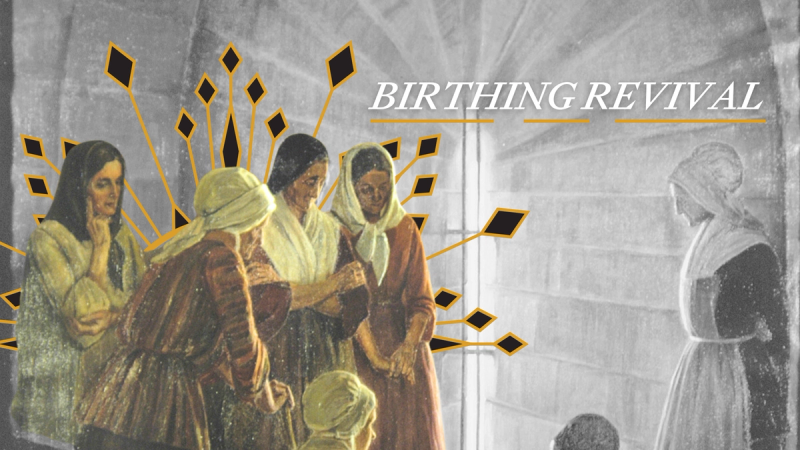Birthing Revival: Women and Mission in Nineteenth-Century France
by Michèle Miller Sigg
Baylor University Press | 2022 | 268 pages (hardcover) | $54.99
Anyone interested in the history of the Protestant church—particularly in the history of women—will be delighted by this book by Michèle Miller Sigg, Executive Director of the Dictionary of African Christian Biography (DACB.org) and Editor of the Journal of African Christian Biography.
The nineteenth-century French Réveil (Awakening) is rather unknown outside of French Protestant circles. By describing this movement and the women who were at its forefront, Birthing Revival fills an important gap.
Yet, Sigg provides more than a simple account of the French Réveil. Those unfamiliar with French Protestant history will find in the first three chapters a simple but fairly comprehensive survey of the French Protestant Church from the Protestant Reformation to the start of the Revéil. And those with a particular interest in missiology will enjoy Sigg’s description of the French missions to Lesotho and the work of women in the Paris Mission Committee.
Each chapter opens with the story of a woman, from Marie Durand, who chose to spend thirty-eight years in the dreadful Tower of Constance rather than deny her Protestant beliefs, to Caroline Malvesin, founder of the Protestant community of the deaconesses of Reuilly. These sketches bring each historical survey to life and honor the lives of women who have been too often forgotten. In fact, most of these sketches contain information that is largely unavailable to readers who are not connected with academic institutions.
The Revéil
Sigg describes the Réveil as “a small nineteenth-century revival movement among French Protestants, members of a minority religion in an overwhelmingly Catholic country. ... The religiosity of the Réveil did not focus first and foremost on reestablishing orthodox doctrine as in the days of the Reformation but instead sought to undo the damage of Enlightenment rationalism and to revive the ‘religion of the heart.’ ... Among those who embraced a ‘revived’ or ‘born again’ faith, some belonged to the Reformed Church while others identified as Quakers, Moravians, Methodists, Baptists, or Lutheran.” (2–3).
Sigg stays faithful to her topic of the French Réveil, only briefly mentioning the Réveil that took place in French Switzerland. While this choice is understandable, a larger treatment of that movement (which shared the same language) would have allowed, in my opinion, a more balanced view of the role of doctrine in the revivals.
For example, the problems described by French philosopher Jean-Jaques Rousseau when he visited the Genevan churches in the eighteenth century were primarily theological: “It is asked, he says of the citizens of Geneva, if Jesus Christ is God. They dare not answer. It is asked if He is a mere man. They are embarrassed and will not say they think so. They are alarmed, terrified, they come together, they discuss, they are in agitation and often earnest consultation and conference.”
And while Sigg devotes several pages to Adolphe Monod, professor at the Seminary of Montauban, France, she doesn’t mention the inner struggle that brought him to reject the faulty theology of the Genevan church and to start a revival. Neither does she mention Robert Haldane’s emphasis on correct theology in his teachings at Geneva and his massive influence all over Europe. Instead, she simply describes him as a co-founder of “a rigidly sectarian missionary society that sent out primarily Swiss evangelists” (60).
These additions would have been helpful to balance descriptions of the French Reformed Church in terms of its “fortress or ‘ghetto’ mentality” and its reactionary response to the Réveil (a response reminiscent of the controversy between the Old Lights and New Lights of the American First Awakening).
It could be that Sigg has chosen to avoid doctrinal issues. When describing the ministry of the Lutheran pastor Francois Haerter, for example, she explains that he struggled with theological questions that caused him in the evening to desire not to wake up in the morning,” and adds that he once preached a sermon on the eternal divinity of Christ which caused “consternation throughout the city and an outcry against what some believed was exalted, foolish doctrine.” (219) Yet, she does not provide details on either one of these instances, leaving countless questions in the minds of a reader who is attuned to theological matters.
A Groundbreaking Resource
Putting aside these issues of doctrinal renewal (which could easily become the subject of another interesting book), we can thoroughly appreciate Sigg’s groundbreaking work. An excellent writer, she is able to transport readers to the past, engaging their imagination and leading them through a wide range of situations, experiences, and opinions.
I recommend this book for several reasons. Besides opening up a largely unexplored portion of church history, it promotes reflections on the place of women in the church.
In her conclusion, Sigg says that “telling the full story of the Réveil requires the historian to adopt a gendered lens.” She explains: “At the beginning of my research, the more I tried to analyze what women were doing at this time through the prevailing lens of their ‘influence,’ often evoked in exalted and yet paradoxically reductive terms in contemporary French texts, the more I realized that it was a false perspective. What I discovered was not simply the diffuse aroma of gentle female ‘influence’ acting upon male family members as women remained within the confines of their traditional roles as ‘spouses, daughters, [and] mothers.’ Au contraire. The Protestant women of Paris acted in concert and with intentionality. They took actions that, together, represented a movement of autonomous women, touched by the Réveil ... These women, spurred on by their reborn fervent faith, acted independently, without male intermediaries, to serve, promote, fundraise, teach, and evangelize.” (229–230).
This does not mean that they did not work with men. In fact, they received much support from both their husbands and several pastors. But they were able to organize and support their massive work of missions, evangelism, and child education autonomously.
Sigg devotes a few pages on the uniqueness of this cooperation. “The ‘feminism’ of early nineteenth-century female Protestant leaders was ambivalent,” she writes, “because even though they increasingly transgressed social mores in the context of their work for missions as time went on, they never bothered to campaign for greater personal freedom and recognition” (142). These women believed they could fulfill their duties “both at home and in the outside world” (143).
The female authors of the Réveil, Sigg continues, “never went so far as to ‘wish themselves a minister,’ as some American missionary wives did. ... Instead, they were content, for now, to remain mostly within what they believed were the spiritual and natural limitations God had set for them. The difficulty of walking such a fine line created some ambivalence in their evolving identity as autonomous women” (147).
This unique situation provides any reader who is interested in the issue of women’s roles within the church an interesting example to observe and compare with other experiences.
Finally, this book can serve the Reformed reader by encouraging some reflections on the state of the Reformed Church at the time of the Réveil. Once again, this is an area where more resources on the concomitant efforts to return to the doctrinal emphasis of the Reformation would have been useful. But this book can be a good starting point.
I personally intend to go back and read this book again slowly, exploring the footnotes and the bibliography. Sadly, these often point to works that are only available in French, or others that are only obtainable through academic institutions. Still, there is plenty of material to explore even for those without a knowledge of French and without academic connections. In the meantime, we can hope for more works on the French Réveil and more translations of French works into English.
Footnotes
Jean Jacques Rousseau, Letters Written from the Mountain, quoted in D.G. Hart, Calvinism, Yale University Press 2013, p. 158
BackElsewhere, Sigg explains that the modern conception of the word “feminism” is not applicable here.
Back




